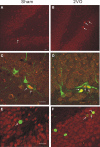Enhanced post-ischemic neurogenesis in aging rats
- PMID: 20877422
- PMCID: PMC2944628
- DOI: 10.3389/fnins.2010.00163
Enhanced post-ischemic neurogenesis in aging rats
Abstract
Hippocampal neurogenesis persists in adult mammals, but its rate declines dramatically with age. Evidence indicates that experimentally-reduced levels of neurogenesis (e.g., by irradiation) in young rats has profound influence on cognition as determined by learning and memory tests. In the present study we asked whether in middle-aged, 10- to 13-months-old rats, cell production can be restored toward the level present in young rats. To manipulate neurogenesis we induced bilateral carotid occlusion with hypotension. This procedure is known to increase neurogenesis in young rats, presumably in a compensatory manner, but until now, has never been tested in aging rats. Cell production was measured at 10, 35, and 90 days after ischemia. The results indicate that neuronal proliferation and differentiation can be transiently restored in middle-aged rats. Furthermore, the effects are more pronounced in the dorsal as opposed to ventral hippocampus thus restoring the dorso-ventral gradient seen in younger rats. Our results support previous findings showing that some of the essential features of the age-dependent decline in neurogenesis are reversible. Thus, it may be possible to manipulate neurogenesis and improve learning and memory in old age.
Keywords: adult neurogenesis; aging; dentate gyrus; hippocampus; ischemia; stroke.
Figures



Similar articles
-
Early Stroke Induces Long-Term Impairment of Adult Neurogenesis Accompanied by Hippocampal-Mediated Cognitive Decline.Cells. 2019 Dec 17;8(12):1654. doi: 10.3390/cells8121654. Cells. 2019. PMID: 31861141 Free PMC article.
-
Decline in adult neurogenesis during aging follows a topographic pattern in the mouse hippocampus.J Comp Neurol. 2011 Feb 15;519(3):451-66. doi: 10.1002/cne.22527. J Comp Neurol. 2011. PMID: 21192078
-
Intracerebroventricular infusion of insulin-like growth factor-I ameliorates the age-related decline in hippocampal neurogenesis.Neuroscience. 2001;107(4):603-13. doi: 10.1016/s0306-4522(01)00378-5. Neuroscience. 2001. PMID: 11720784
-
Adult neurogenesis in the mammalian dentate gyrus.Anat Histol Embryol. 2020 Jan;49(1):3-16. doi: 10.1111/ahe.12496. Epub 2019 Sep 30. Anat Histol Embryol. 2020. PMID: 31568602 Review.
-
Hippocampal learning, memory, and neurogenesis: Effects of sex and estrogens across the lifespan in adults.Horm Behav. 2015 Aug;74:37-52. doi: 10.1016/j.yhbeh.2015.05.024. Epub 2015 Jun 27. Horm Behav. 2015. PMID: 26122299 Review.
Cited by
-
Mechanisms underlying the effect of voluntary running on adult hippocampal neurogenesis.Hippocampus. 2023 Apr;33(4):373-390. doi: 10.1002/hipo.23520. Epub 2023 Mar 9. Hippocampus. 2023. PMID: 36892196 Free PMC article. Review.
-
Depletion of new neurons by image guided irradiation.Front Neurosci. 2011 Apr 21;5:59. doi: 10.3389/fnins.2011.00059. eCollection 2011. Front Neurosci. 2011. PMID: 21541259 Free PMC article.
-
Neurogenesis response of middle-aged hippocampus to acute seizure activity.PLoS One. 2012;7(8):e43286. doi: 10.1371/journal.pone.0043286. Epub 2012 Aug 17. PLoS One. 2012. PMID: 22912847 Free PMC article.
-
Neural proliferation and restoration of neurochemical phenotypes and compromised functions following capsaicin-induced neuronal damage in the nodose ganglion of the adult rat.Front Neurosci. 2011 Feb 2;5:12. doi: 10.3389/fnins.2011.00012. eCollection 2011. Front Neurosci. 2011. PMID: 21344007 Free PMC article.
-
Anatomical and functional connections between the locus coeruleus and the nucleus tractus solitarius in neonatal rats.Neuroscience. 2016 Jun 2;324:446-68. doi: 10.1016/j.neuroscience.2016.03.036. Epub 2016 Mar 19. Neuroscience. 2016. PMID: 27001176 Free PMC article.
References
-
- Darsalia V., Heldmann U., Lindvall O., Kokaia Z. (2005). Stroke-induced neurogenesis in aged brain. Stroke 36, 1790–179510.1161/01.STR.0000173151.36031.be - DOI - PubMed
LinkOut - more resources
Full Text Sources

